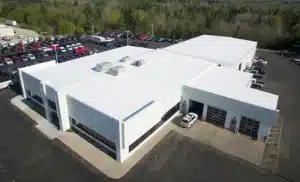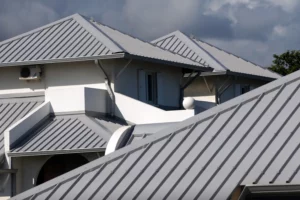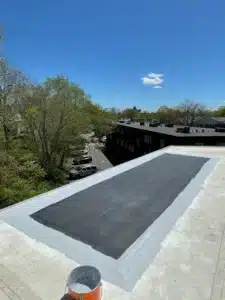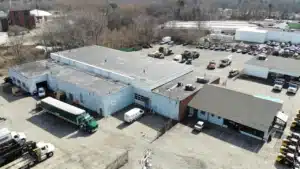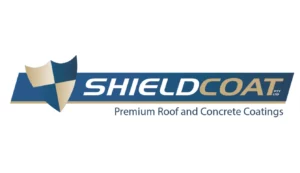The Basics of Cutting Corrugated Metal Roofing
If you’re considering installing corrugated metal roofing for your commercial property, you may be wondering how to cut it properly. Cutting corrugated metal roofing can be a bit challenging if you don’t have the right tools or knowledge. In this article, we’ll provide you with some valuable information and tips on how to cut corrugated metal roofing effectively.
1. Choose the Right Cutting Tool
One of the most important things to consider when cutting corrugated metal roofing is the type of cutting tool you’ll be using. There are several options available, such as tin snips, electric shears, and power saws. Tin snips are ideal for small and precise cuts, while electric shears are great for straight and curved cuts. Power saws, on the other hand, are perfect for cutting corrugated metal roofing quickly and efficiently. Remember to wear safety goggles and gloves while using any cutting tool.
2. Measure and Mark Your Cuts
Before starting the cutting process, it’s crucial to measure and mark your cuts carefully. Use a tape measure to determine the exact dimensions you need for your corrugated metal roofing. Mark the measurements directly on the metal using a permanent marker or chalk. Double-check your markings to ensure accuracy before proceeding with the cutting.
3. Get the Right Technique
Using the correct technique is essential for clean and precise cuts. When using tin snips, it’s best to start at the edge of the corrugation and cut in a straight line. For electric shears, follow the same method but with a continuous motion. If you’re using a power saw, use a metal-cutting blade and cut slowly and steadily. Remember to apply moderate pressure to avoid bending or denting the metal.
4. Take Safety Precautions
Safety should always be a priority when working with any cutting tool. Ensure that your work area is clear of any debris or obstacles that could cause accidents. Wear appropriate safety gear, including safety goggles, gloves, and ear protection if necessary. Handle the cutting tools with care, following the manufacturer’s instructions. If you’re unsure about how to operate a particular tool, seek professional advice or training.
5. Use Proper Support
To make the cutting process easier and more precise, use proper support for the corrugated metal roofing. Place the metal on a stable surface such as sawhorses or a workbench. This will help prevent accidental slips or vibrations that could affect the accuracy of your cuts. Additionally, make sure the metal is firmly held or clamped down to avoid any movement while cutting.
6. Practice Makes Perfect
Cutting corrugated metal roofing may take some practice to achieve the desired results. If you’re new to this task, consider practicing on a small piece of scrap metal before working with the actual roofing material. This will allow you to familiarize yourself with the cutting tools and techniques, ensuring better results when working on your commercial property.
The Art of Installing Corrugated Metal Roofing
1. Prepare the Roof
Before installing corrugated metal roofing, ensure that the roof is clean, dry, and free of any debris. Remove any existing roofing material or nails that may interfere with the installation. Inspect the roof for any repairs or damage that need to be addressed before proceeding.
2. Measure and Cut
Measure the dimensions of your roof accurately and cut the corrugated metal panels accordingly. Use the techniques mentioned earlier in this article to achieve clean and precise cuts. It’s essential to have the right measurements to avoid wastage or gaps during installation.
3. Attach the Roofing Panels
Starting from one edge of the roof, align the first panel and secure it in place with roofing screws or nails. Ensure that the panel is straight and level. Repeat this process for the remaining panels, overlapping each one slightly to provide proper protection against water and other elements. Use rubber washers or neoprene gaskets with the screws or nails to create a watertight seal.
4. Install Flashing and Ridge Caps
To prevent water leakage, install flashing along the edges and valleys of the roof. This will provide a protective barrier and ensure water flows off the roof properly. Additionally, install ridge caps along the top ridge of the roof for added strength and protection. Secure the flashing and ridge caps using appropriate fasteners and sealant.
5. Conduct a Final Inspection
Once the installation is complete, it’s crucial to conduct a thorough inspection of the roof. Check for any loose panels, improper sealing, or other issues that may affect the integrity of the installation. Make any necessary adjustments or repairs before considering the project finished.
6. Regular Maintenance
To ensure the longevity of your corrugated metal roofing, it’s essential to conduct regular maintenance. Inspect the roof periodically for any signs of damage, such as loose panels, rust, or corrosion. Clean the roof as needed to remove dirt, debris, or leaves that may accumulate over time. Promptly address any maintenance issues to prevent further damage or costly repairs.
Conclusion
Cutting and installing corrugated metal roofing for your commercial property may seem daunting, but with the right tools and techniques, it can be a manageable task. Remember to choose the appropriate cutting tool, measure and mark your cuts accurately, and practice proper safety precautions. When installing the roofing panels, prepare the roof, measure and cut accordingly, and ensure proper attachment and sealing. With regular maintenance and inspections, your corrugated metal roofing will continue to protect your commercial property for years to come.

